Environmental Impact of Geosynthetics in Coastal Protection
Abstract
1. Introduction
2. Materials and Methods
2.1. Accelerated Ageing Using Autoclave Test
2.2. Dynamic Surface Leaching Test
2.3. Ecotoxicological Testing
2.4. Continuous Visual Scanning (Field Study)
3. Results
3.1. Field Study on Kaliningrad Oblast Shore (Russia)
3.2. Tensile Tests after Accelerated Ageing Using Autoclave Test
3.3. Ecotoxicity Tests
4. Discussion
Author Contributions
Funding
Institutional Review Board Statement
Informed Consent Statement
Data Availability Statement
Conflicts of Interest
References
- Müller, W.W.; Saathoff, F. Geosynthetics in geoenvironmental engineering. Sci. Technol. Adv. Mater. 2015, 16, 034605. [Google Scholar] [CrossRef] [PubMed]
- Wu, H.; Yao, C.; Li, C.; Miao, M.; Zhong, Y.; Lu, Y.; Liu, T. Review of Application and Innovation of Geotextiles in Geotechnical Engineering. Materials 2020, 13, 1774. [Google Scholar] [CrossRef] [PubMed]
- Wiewel, B.V.; Lamoree, M.H. Geotextile composition, application and ecotoxicology—A review. J. Hazard. Mater. 2016, 317, 640–655. [Google Scholar] [CrossRef] [PubMed]
- Bandow, N.; Aitken, M.D.; Geburtig, A.; Kalbe, U.; Piechotta, C.; Schoknecht, U.; Simon, F.-G.; Stephan, I. Using Environmental Simulations to Test the Release of Hazardous Substances from Polymer-Based Products: Are Realism and Pragmatism Mutually Exclusive Objectives? Materials 2020, 13, 2709. [Google Scholar] [CrossRef] [PubMed]
- Simon, F.G.; Wachtendorf, V.; Geburtig, A.; Trubiroha, P. Materials and the environment, Environmental Impact of Materials. In Springer Handbook of Metrology and Testing; Czichos, H., Saito, T., Smith, L., Eds.; Springer: Heidelberg, Germany, 2011; pp. 845–860. [Google Scholar]
- Oberbeckmann, S.; Löder, M.G.J.; Labrenz, M. Marine microplastic-associated biofilms—A review. Environ. Chem. 2015, 12, 551–562. [Google Scholar] [CrossRef]
- Carneiro, J.R.; Morais, M.; Lopes, M.D.L. Degradation of polypropylene geotextiles with different chemical stabilisations in marine environments. Constr. Build. Mater. 2018, 165, 877–886. [Google Scholar] [CrossRef]
- Hsieh, C.; Chiu, Y.-F.; Wang, J.-B. Weathering properties of geotextiles in ocean environments. Geosynth. Int. 2006, 13, 210–217. [Google Scholar] [CrossRef]
- Tosin, M.; Weber, M.; Esiotto, M.; Lott, C.; Degli-Innocenti, F. Laboratory Test Methods to Determine the Degradation of Plastics in Marine Environmental Conditions. Front. Microbiol. 2012, 3, 225. [Google Scholar] [CrossRef]
- Andrady, A.L. Microplastics in the marine environment. Mar. Pollut. Bull. 2011, 62, 1596–1605. [Google Scholar] [CrossRef]
- Kershaw, R.P. Biodegradable Plastics and Marine Litter. Misconceptions, Concerns and Impacts on Marine Environments; United Nations Environment Programme (UNEP): Nairobi, Kenya, 2015; ISBN 978-92-807-3494-2. [Google Scholar]
- Chubarenko, I.P.; Bagaev, A.; Zobkova, M.; Esiukova, E.E. On some physical and dynamical properties of microplastic particles in marine environment. Mar. Pollut. Bull. 2016, 108, 105–112. [Google Scholar] [CrossRef]
- Morét-Ferguson, S.; Law, K.L.; Proskurowski, G.; Murphy, E.K.; Peacock, E.E.; Reddy, C.M. The size, mass, and composition of plastic debris in the western North Atlantic Ocean. Mar. Pollut. Bull. 2010, 60, 1873–1878. [Google Scholar] [CrossRef] [PubMed]
- Lobelle, D.; Cunliffe, M. Early microbial biofilm formation on marine plastic debris. Mar. Pollut. Bull. 2011, 62, 197–200. [Google Scholar] [CrossRef] [PubMed]
- Barnes, D.K.A.; Galgani, F.; Thompson, R.C.; Barlaz, M. Accumulation and fragmentation of plastic debris in global environments. Philos. Trans. R. Soc. B Biol. Sci. 2009, 364, 1985–1998. [Google Scholar] [CrossRef]
- Woodall, L.C.; Sanchez-Vidal, A.; Canals, M.; Paterson, G.L.J.; Coppock, R.; Sleight, V.; Calafat, A.; Rogers, A.D.; Narayanaswamy, B.E.; Thompson, R.C. The deep sea is a major sink for microplastic debris. R. Soc. Open Sci. 2014, 1, 140317. [Google Scholar] [CrossRef]
- Simon, F.G.; Barqawi, H.; Chubarenko, B.; Esiukova, E.; Putna-Nimane, I.; Barda, I.; Strode, E.; Purina, I. EI-GEO Environmental Impact of Geosynthetics in aquatic systems. In 3rd Baltic Earth Conference, Earth System Changes and Baltic Sea Coasts, International Baltic Earth Secretariat Publications; Köppen, S., Reckermann, M., Eds.; International Baltic Earth Secretariat Publications: Geesthacht, Germany, 2020; pp. 151–152. [Google Scholar]
- Müller, W.W.; Simon, F.; Wöhlecke, A. 30 Jahre BAM-Zulassung (in der Deponietechnik): Material- und prüftechnische Entwicklungen. Bautechnik 2019, 96, 912–918. [Google Scholar] [CrossRef]
- Holmes, L.A.; Turner, A.; Thompson, R.C. Interactions between trace metals and plastic production pellets under estuarine conditions. Mar. Chem. 2014, 167, 25–32. [Google Scholar] [CrossRef]
- DIN CEN/TS 16637-2. Construction Products—Assessment of Release of Dangerous Substances—Part 2: Horizontal Dynamic Surface Leaching Test; German Institute for Standardization, Beuth-Verlag: Berlin, Germany, 2014. [Google Scholar]
- ISO 6341. Water quality–Determination of the Inhibition of the Mobility of Daphnia Magna Straus (Cladocera, Crustacea)–Acute Toxicity Test; International Standardization Organization: Geneva, Switzerland, 2012. [Google Scholar]
- ISO 16303. Water quality–Determination of Toxicity of Fresh Water Sediments Using Hyalella Azteca; International Standardization Organization: Geneva, Switzreland, 2013. [Google Scholar]
- ISO 8692. Water quality–Fresh Water Algal Growth Inhibition Test with Unicellular Green Algae; International Standardization Organization: Geneva, Switzerland, 2012. [Google Scholar]
- Haseler, M.; Balciunas, A.; Hauk, R.; Sabaliauskaite, V.; Chubarenko, I.; Ershova, A.; Schernewski, G. Marine Litter Pollution in Baltic Sea Beaches–Application of the Sand Rake Method. Front. Environ. Sci. 2020, 8, 599978. [Google Scholar] [CrossRef]
- Chubarenko, I.P.; Esiukova, E.; Khatmullina, L.; Lobchuk, O.; Grave, A.; Kileso, A.; Haseler, M. From macro to micro, from patchy to uniform: Analyzing plastic contamination along and across a sandy tide-less coast. Mar. Pollut. Bull. 2020, 156, 111198. [Google Scholar] [CrossRef]
- Esiukova, E.E.; Chubarenko, B.V.; Chubarenko, I.P.; Kileso, A.V.; Zhelezova, E.V.; Grave, A.V.; Cukanova, E.S.; Sobaeva, D.A.; Tanurkov, A.G.; Yushmanova, A.V.; et al. Method of selection and accounting of fragments of geosynthetic materials and its testing at the beaches of the South-Eastern Baltic. In XXVII International Shore Conference Arctic Coast: The Path to Sustainability; MAGU Publisher: Murmansk, Russia, 2018. [Google Scholar]
- Esiukova, E.E.; Chubarenko, B.V.; Simon, F.-G. Debris of geosynthetic materials on the shore of the South-Eastern Baltic (Kaliningrad Oblast, the Russian Federation). In Proceedings of the 2018 IEEE/OES Baltic International Symposium (BALTIC), Klaipeda, Lithuania, 12–15 June 2018; pp. 1–6. [Google Scholar] [CrossRef]
- Esiukova, E.E.; Kileso, A.V.; Chubarenko, B.V.; Pinchuk, V.S. Geosynthetic debris on the beaches of Kaliningrad Oblast –result of systematic assessment of 2018. In Proceedings of the Baltic Sea Science Congress (BSSC), Stockholm, Sweden, 23 August 2019. [Google Scholar]
- Sokolov, A.; Chubarenko, B.V.; Umgiesser, G. Hydrodynamic conditions near the northern shore of Sambian Peninsula (the Baltic Sea) as a basis of geotextile debris transport analysis. In Proceedings of the 2018 IEEE/OES Baltic International Symposium (BALTIC); Williams, A.J., Ed.; IEEE Xplore: New York, NY, USA, 2018; pp. 1–6. [Google Scholar] [CrossRef]
- Babakov, A.N.; Chubarenko, B.V. The Structure of the Net Alongshore Sediment Transport in the Eastern Gulf of Gdansk. Water Resour. 2019, 46, 515–529. [Google Scholar] [CrossRef]
- Verdu, J. Oxidative Ageing of Polymers; ISTE Ltd.: London, UK, 2012. [Google Scholar]
- Robertson, D. The oxidative resistance of polymeric geosynthetic barriers (GBR-P) used for road and railway tunnels. Polym. Test. 2013, 32, 1594–1602. [Google Scholar] [CrossRef]
- Schröder, H.F.; Munz, M.; Böhning, M. A New Method for Testing and Evaluating the Long-Time Resistance to Oxidation of Polyolefinic Products. Polym. Polym. Compos. 2008, 16, 71–79. [Google Scholar] [CrossRef]
- Hausmann, S.; Zanzinger, H.; Armani, A. Oxidative lifetime prediction of a polypropylene woven geotextile by applying high temperature and moderately increased oxygen pressure. Geotext. Geomembr. 2020, 48, 479–490. [Google Scholar] [CrossRef]
- Tromans, D. Temperature and pressure dependent solubility of oxygen in water: A thermodynamic analysis. Hydrometallurgy 1998, 48, 327–342. [Google Scholar] [CrossRef]
- Sander, R. Compilation of Henry’s law constants (version 4.0) for water as solvent. Atmos. Chem. Phys. Discuss. 2015, 15, 4399–4981. [Google Scholar] [CrossRef]
- Rani, M.; Shim, W.J.; Han, G.M.; Jang, M.; Al-Odaini, N.A.; Song, Y.K.; Hong, S.H. Qualitative Analysis of Additives in Plastic Marine Debris and Its New Products. Arch. Environ. Contam. Toxicol. 2015, 69, 352–366. [Google Scholar] [CrossRef]
- Gartiser, S.; Heisterkamp, I.; Schoknecht, U.; Bandow, N.; Burkhardt, N.M.; Ratte, M.; Ilvonen, O. Recommendation for a test battery for the ecotoxicological evaluation of the environmental safety of construction products. Chemosphere 2017, 171, 580–587. [Google Scholar] [CrossRef]
- Hsuan, Y.G.; Olson, M.S.; Spatari, S.; Cairncross, R.; Kilham, S. The roles of geomembranes in algae production at landifills. Geosynthetics 2012, 30, 34–41. [Google Scholar]
- Sachs, F.; Sivaselvan, M.V. Cell volume control in three dimensions: Water movement without solute movement. J. Gen. Physiol. 2015, 145, 373–380. [Google Scholar] [CrossRef]
- US EPA. Method Guidance and Recommendations for Whole Effluent Toxicity (WET) Testing (40 CFR Part 136), Guidance Document, EPA 821-B-00-004; United States Environmental Protection Agency, Office of Water: Washington, DC, USA, 2000.
- Esiukova, E.E.; Chubarenko, B.V. Geosynthetic debris–new pollutant as a result of coastal protection. In Proceedings of the XX International Environmental Forum “Baltic Sea Day”, St. Petersburg, Russia, 21–23 March 2019; pp. 80–82. [Google Scholar]
- Kileso, A.V.; Esiukova, E.E.; Pinchuk, V.S. Traces of the transboundary pollution of the shore of the Southeastern Baltic by the debris of geosynthetic materials. In Proceedings of the IV International Scientific and Practical Conference (Dedicated to the 1000th Anniversary of the City of Brest), Current Problems of Earth Sciences Research of Cross-Border Regions, Brest, Belarus, 5–6 December 2019; pp. 215–216. [Google Scholar]
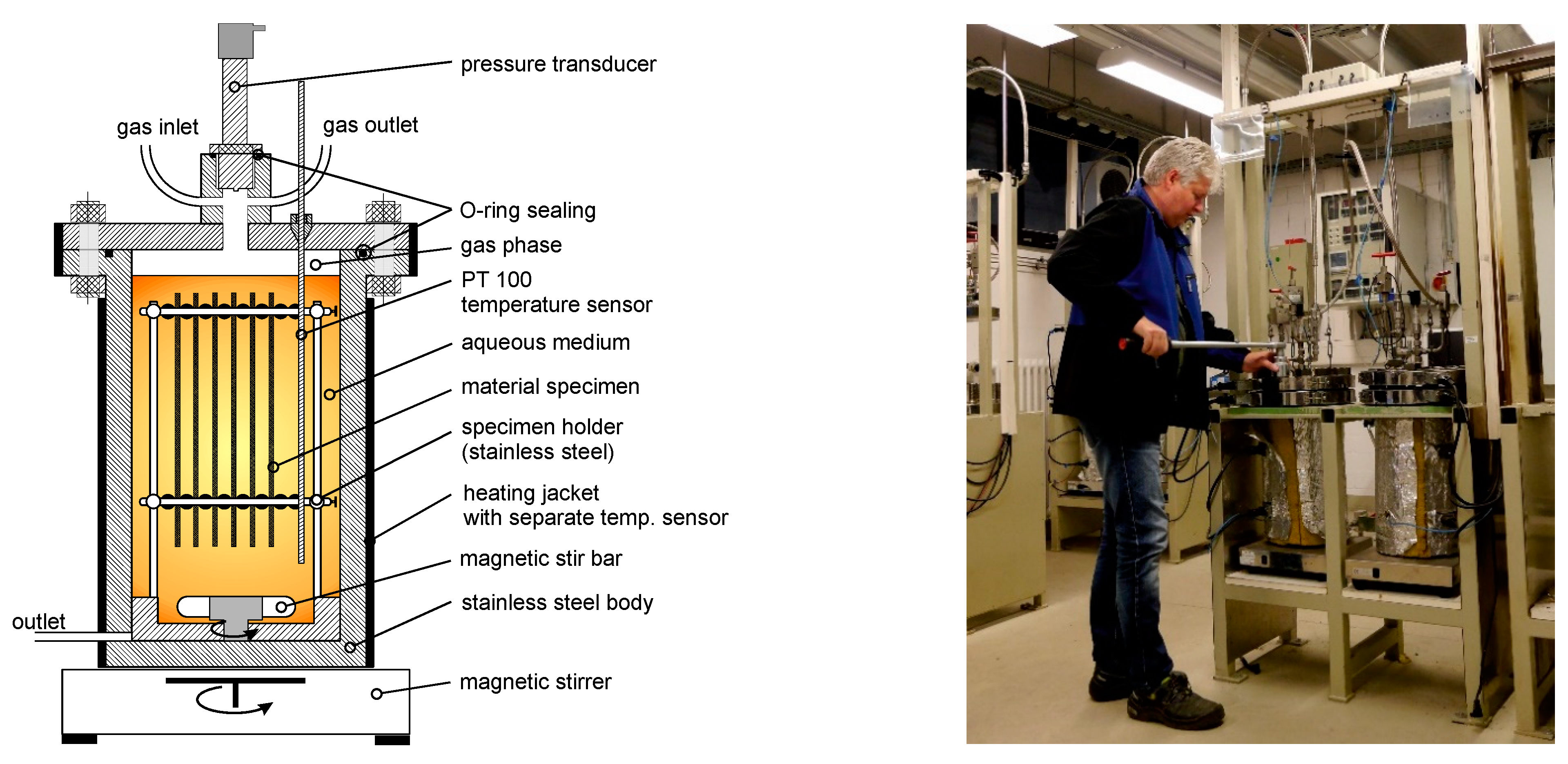
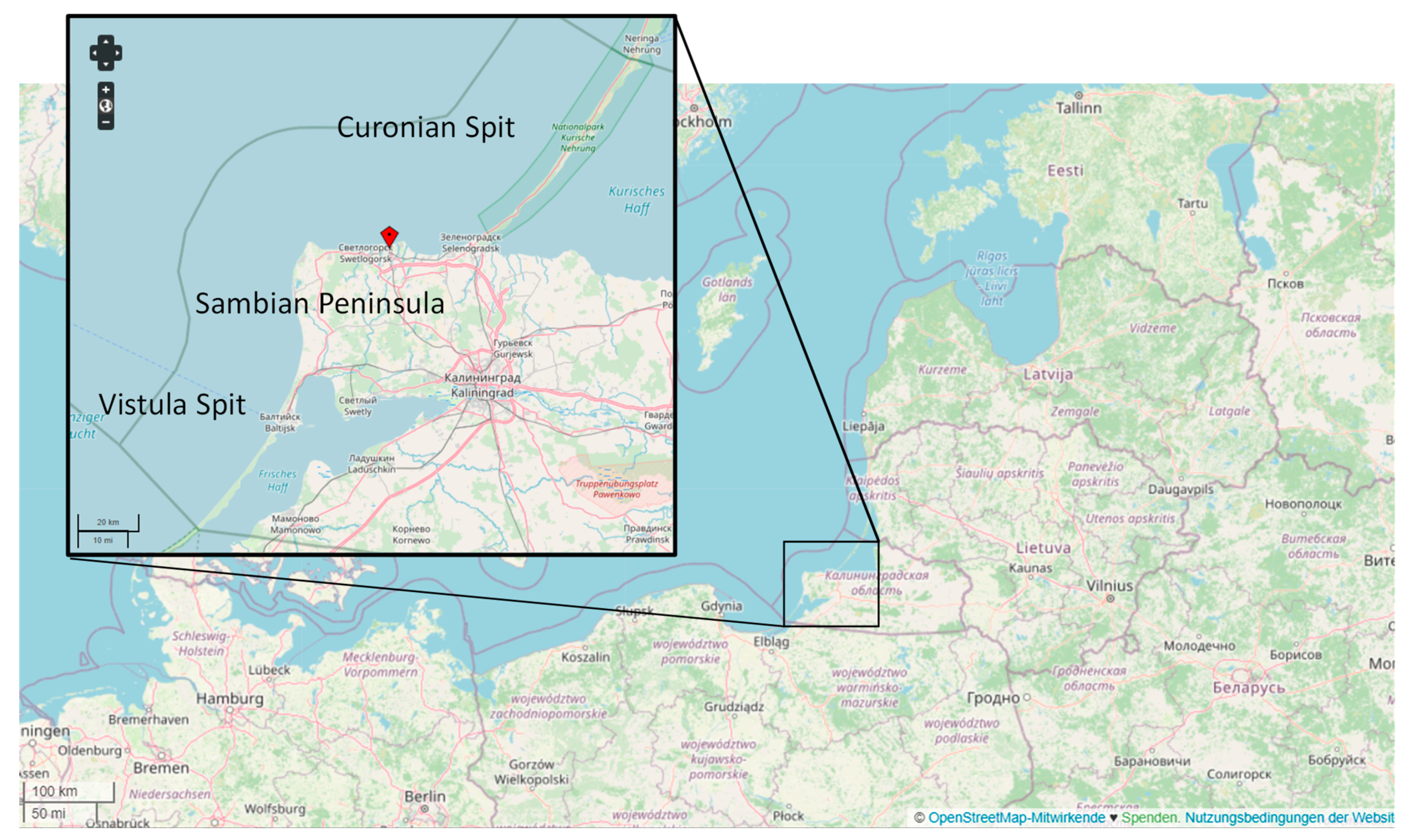
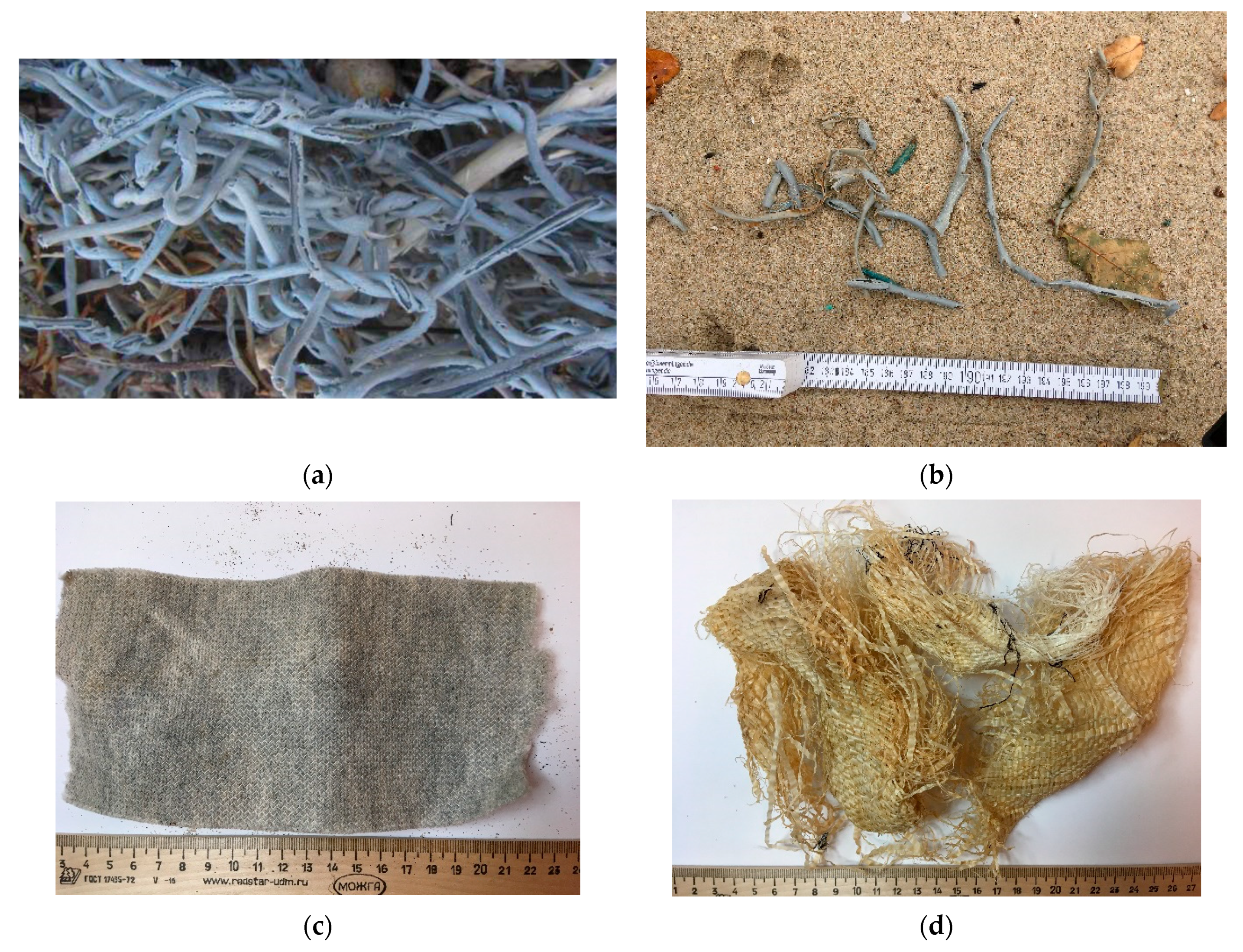
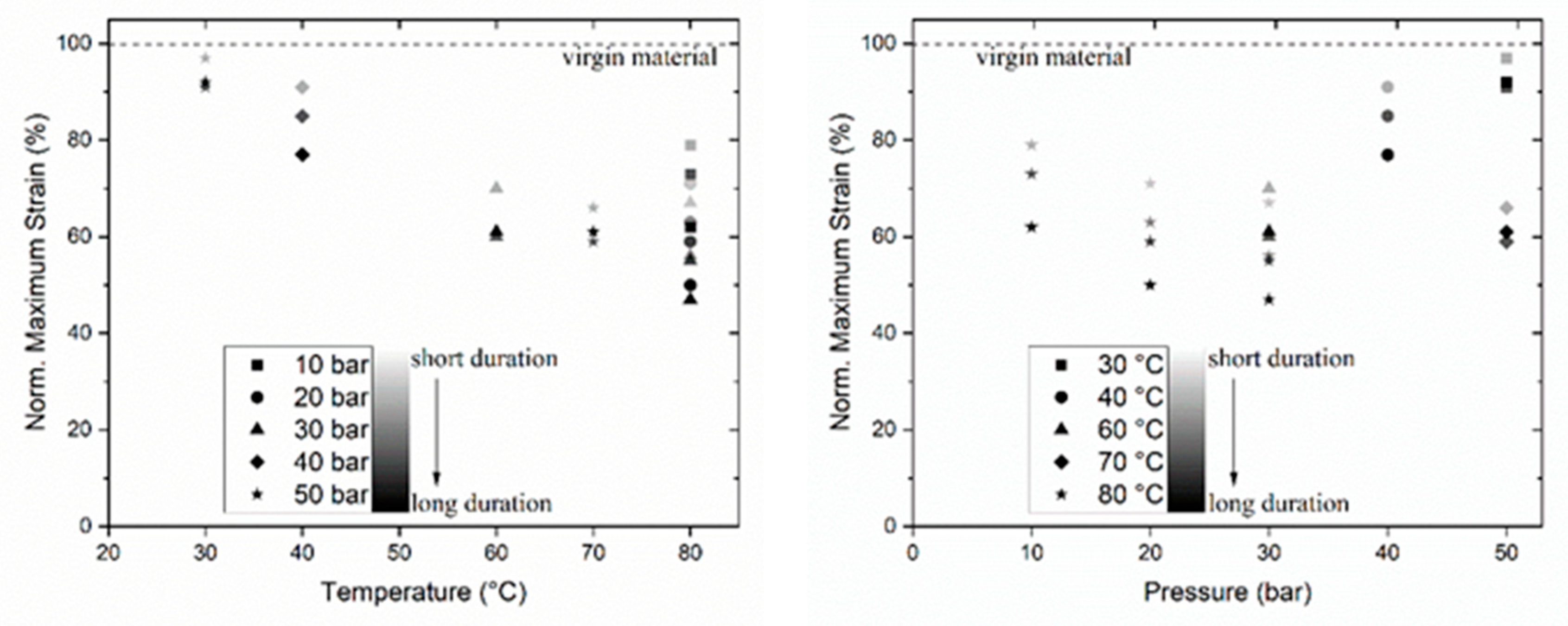
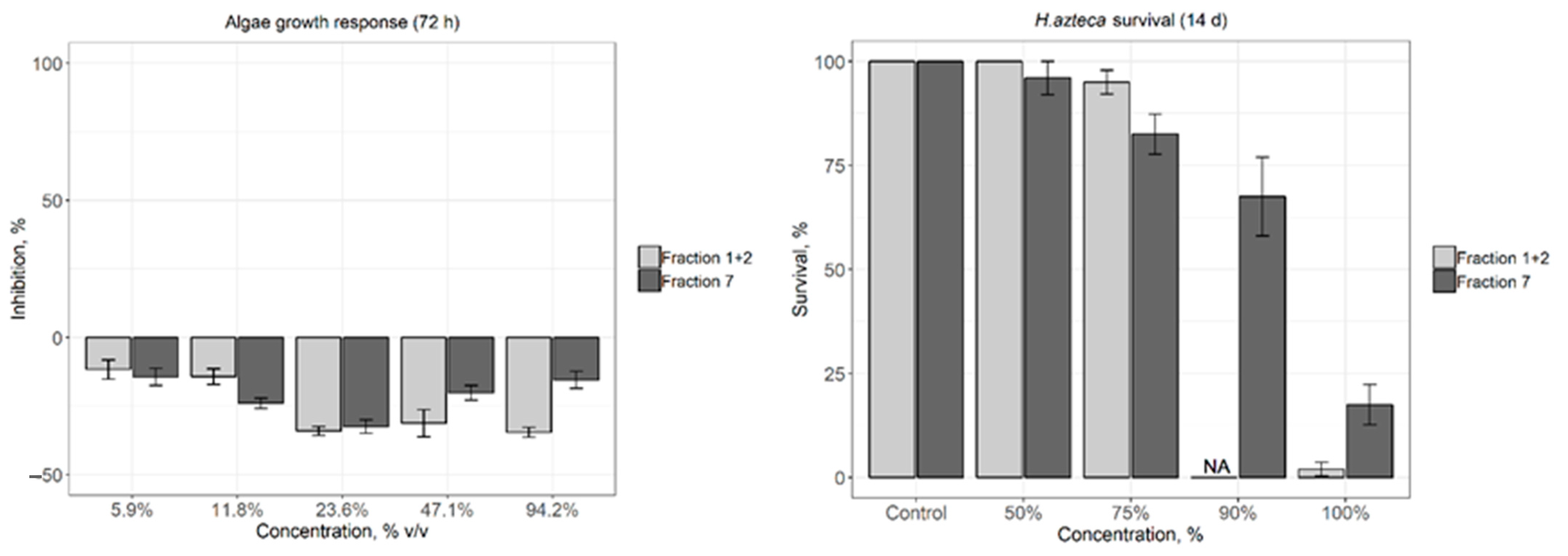
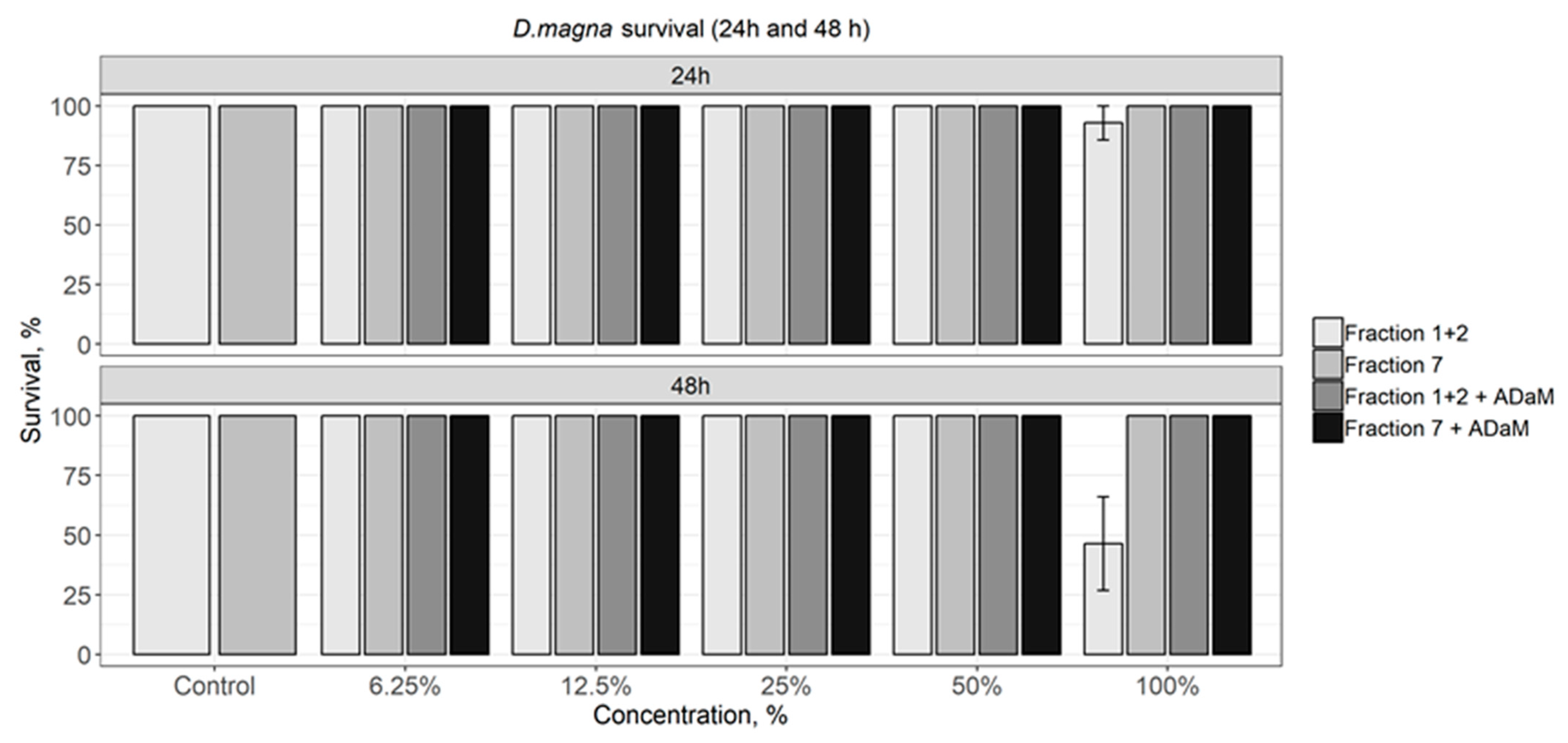
| p (bar) | Temperature (K) | ||||
|---|---|---|---|---|---|
| 303 | 313 | 333 | 343 | 353 | |
| 10 | - | - | - | - | 14, 44, 61 |
| 20 | - | - | - | - | 27, 54, 82, 140 |
| 30 | - | - | 70, 102, 144 | - | 28, 38, 48, 77 |
| 40 | - | 70, 101, 143 | - | - | - |
| 50 | 70, 101, 143 | - | - | 70, 101, 143 | - |
| Standard | ISO 6341:2012 [21] | ISO 16303:2013 [22] | ISO 8692:2012 [23] |
|---|---|---|---|
| Test organisms | Daphnia magna | Hyalella azteca | Desmodesmus subspicatus |
| Test duration | 48 h | 14 days | 72 h |
| Temperature | 20 ± 1 °C | 23 ± 1 °C | 23 ± 2 °C |
| Growth media | ADaM * | ADaM | BG-11 |
| Test chamber size | 6 vial plates | 400 mL low form beakers | 300 µL |
| Test volume | 15 mL | 250 mL | 265 µL |
| Age of test organisms | Less than 24 h old | 11 days old at test initiation (1 to 2 day range in age) | Algae culture in exponencial growth phase |
| Organisms per test chamber | 7 | 10 | 5 µL (104 cells) |
| Replicates per treatment | 4 | 4 | 6 |
| Test concentrations | (100%; 50%; 25%; 12.5%; 6.3% | 100%; 75%; 50%; 25%; 12.5%; 6.3%; 3.1% | 5.9%, 11.8%, 23.6%, 47.2%, 94.3% |
| Feeding regime | No | YCT food, fed 0.5 mL daily/chamber | Concentrated BG11 (10 µL)/vial in beginning of test |
| Endpoints | Mortality | Survival (optional, growth by dry weight or length) | Growth inhibition |
| Reference toxicant | K2Cr2O7 24 h LC 50 0.81 mg/L | CdCl2 (Cd 96 h LC50 = 0.007 mg/L), CuSO4 (Cu 96 h LC 50 = 0.24–0.33 mg/L) | ISO mentioned intercalibration K2Cr2O7 72 h EC 50 = 0.84 mg/L |
| Morphodynamic Segments of the Shore | Geotextile | Gabion Coating | “Big Bags” | Geocell |
|---|---|---|---|---|
| Vistula Spit | 0.01 | 0.13 | 0.25 | 0 |
| Western shore of the Sambian Peninsula | 0 | 0.18 | 0.15 | 0 |
| Northern shore of the Sambian Peninsula | 2.90 | 9.38 | 5.98 | 0.13 |
| Curonian Spit | 0.24 | 1.97 | 4.26 | 0.09 |
Publisher’s Note: MDPI stays neutral with regard to jurisdictional claims in published maps and institutional affiliations. |
© 2021 by the authors. Licensee MDPI, Basel, Switzerland. This article is an open access article distributed under the terms and conditions of the Creative Commons Attribution (CC BY) license (http://creativecommons.org/licenses/by/4.0/).
Share and Cite
Scholz, P.; Putna-Nimane, I.; Barda, I.; Liepina-Leimane, I.; Strode, E.; Kileso, A.; Esiukova, E.; Chubarenko, B.; Purina, I.; Simon, F.-G. Environmental Impact of Geosynthetics in Coastal Protection. Materials 2021, 14, 634. https://doi.org/10.3390/ma14030634
Scholz P, Putna-Nimane I, Barda I, Liepina-Leimane I, Strode E, Kileso A, Esiukova E, Chubarenko B, Purina I, Simon F-G. Environmental Impact of Geosynthetics in Coastal Protection. Materials. 2021; 14(3):634. https://doi.org/10.3390/ma14030634
Chicago/Turabian StyleScholz, Philipp, Ieva Putna-Nimane, Ieva Barda, Ineta Liepina-Leimane, Evita Strode, Alexandr Kileso, Elena Esiukova, Boris Chubarenko, Ingrida Purina, and Franz-Georg Simon. 2021. "Environmental Impact of Geosynthetics in Coastal Protection" Materials 14, no. 3: 634. https://doi.org/10.3390/ma14030634
APA StyleScholz, P., Putna-Nimane, I., Barda, I., Liepina-Leimane, I., Strode, E., Kileso, A., Esiukova, E., Chubarenko, B., Purina, I., & Simon, F.-G. (2021). Environmental Impact of Geosynthetics in Coastal Protection. Materials, 14(3), 634. https://doi.org/10.3390/ma14030634










